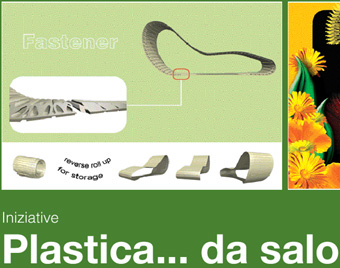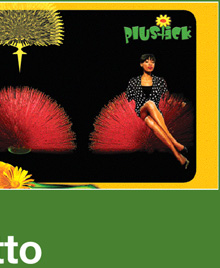


 |
 |
 |
 |
Plastica... da salotto
Plastic... in the living-room
|
Sotto i riflettori, al Salone del Mobile di Milano, i sei progetti vincitori di Plastic 4 the house, concorso indetto da Corepla e PlasticsEurope Italia.
In the spotlight at the Salone del Mobile in Milan are the six “Plastic 4 the house” award-winning projects, the competition organised by Corepla and PlasticsEurope Italia.
|
|
Laws&Decrees
|
|
News
|
|
|


|
|

DESIGN E RICICLO Sotto i riflettori, al Salone del Mobile di Milano, i sei progetti vincitori di Plastic 4 the house, concorso indetto da Corepla e PlasticsEurope Italia per promuovere e valorizzare un materiale dalle molte vite. M.P.
Una sedia che fiorisce, un pannello con le tasche, una chaise longue in rotolo... Ecco fin dove può arrivare la fertile creatività del designer, quando incontra sulla sua strada un materiale poliedrico e “plasmabile” come la plastica.
Un incontro reso possibile da Corepla che l’anno scorso, in collaborazione con PlasticsEurope Italia (l’Associazione dei Produttori di materie plastiche che opera in seno a Federchimica) e Casa Vogue, ha indetto il concorso Plastic 4 the house, destinato a tutti gli studenti di arte e design d’Italia.
La sfida lanciata dal consorzio per il recupero delle materie plastiche consisteva nel dare vita a un inedito complemento d’arredo per la casa, da realizzare in plastica vergine e riciclata, a dimostrazione di ciò che questo materiale - e i relativi rifiuti da imballaggio - sono in grado di fare. I risultati, come suggeriscono gli esempi citati in apertura, si sono dimostrati all’altezza di ogni aspettativa, interpretando la consegna con creatività e coerenza: originali nelle forme e sorprendenti nell’associare a queste ultime funzioni (spesso anche più di una) tutte da scoprire, in un intrigante equilibrio tra praticità e ludicità, i progetti vincenti ben incarnano la versatilità e il fascino “leggero” (anche in senso letterale) del materiale impiegato.
Dal progetto all’oggetto, dalla casa alla città
I vincitori di Plastic 4 the house si sono inoltre aggiudicati la possibilità di seguire uno stage presso un’azienda del settore, dove avranno modo di trasformare in realtà le proprie idee, con il supporto di progettisti e disegnatori professionisti. Per passare poi alla fase di produzione industriale propedeutica alla commercializzazione vera e propria, Corepla metterà a disposizione delle aziende il proprio reparto di Ricerca & Sviluppo.
Nel frattempo, in attesa che gli originali complementi di arredo passino “dalla carta alla plastica”, i sei progetti selezionati (tre vincitori più altrettante menzioni d’onore) sono approdati al Salone del Mobile 2005 di Milano. Il nutrito pubblico del Fuori Salone ha infatti potuto ammirare i sei concept, con relativi moke up, all’interno di una mostra allestita ad hoc da Corepla, PlasticsEurope Italia e Casa Vogue che, con l’occasione, hanno annunciato l’edizione 2005 del concorso. In un ideale percorso che va dalla casa alla città, dallo spazio privato a quello pubblico, Plastic 4 the house diventa Plastic 4 the city: i giovani designer saranno dunque chiamati a dar sfogo alla propria creatività progettando pensiline, cassonetti, panchine e altri oggetti di arredo urbano tutti, ovviamente, di plastica vergine e riciclata. I progetti vincitori verranno sottoposti quindi ad amministrazioni pubbliche e ad aziende private.
|
 |

Initiatives
Plastic... in the living-room
DESIGN AND RECYCLING - In the spotlight at the Salone del Mobile in Milan are the six "Plastic 4 the house" award-winning projects, the competition organised by Corepla and PlasticsEurope Italia to promote and enhance a material with multiple lives.
M.P.
A flowering chair, a panel with pockets, a chaise longue in a roll... These are some of the new horizons for the fertile creativity of designers when they encounter that multi-faceted and "malleable" material, plastic. An encounter made possible by Corepla that, together with PlasticsEurope Italia (the Association of Plastics Producers within Federchimica) and Casa Vogue, announced the "Plastic 4 the house" competition last year, open to all art and design students in Italy.
The challenge posed by this consortium for the recovery of plastics consisted in creating unprecedented interior furnishings, to be made from virgin and recycled plastic, to prove just what this material - and the relevant packaging waste - can do.
The results, as the examples above show, fully met expectations, interpreting the brief with creativity and coherence: original and surprising shapes associated with functions (indeed, often several functions) waiting to be discovered in an intriguing balance between practicality and fun. The winning projects embody the versatility and “light” (also literally) attractiveness of the material used.
From the project to the object, from the home to the city
The winners of "Plastic 4 the house" also won the chance of a training period with a company in this industry, where they will have the opportunity to turn their ideas into reality, with the support of professional designers and project engineers. Then the design will pass to the industrial production stage, aimed at proper marketing of the product. To this purpose, Corepla will make available its R&D department. Meantime, while the original furniture designs pass “from paper to plastic”, the six selected projects (3 winners plus 3 merits) were exhibited at the Salone del Mobile 2005 in Milan.
The large public visiting the “Fuori Salone” - events organized parallel to the official show - had the chance to admire the six concepts and corresponding mock-ups in an ad hoc show staged by Corepla, PlasticsEurope Italia and Casa Vogue, who used the occasion to announce the 2005 edition of the competition. With an ideal development from the home to the city, from private space to public space, "Plastic 4 the house" becomes "Plastic 4 the city": young designers will be called upon to use all their creativity to design shelters, benches, bins and other forms of street furniture, all, needless to say, made from virgin and recycled plastic. The winning projects will then be submitted to public authorities and private companies.
|